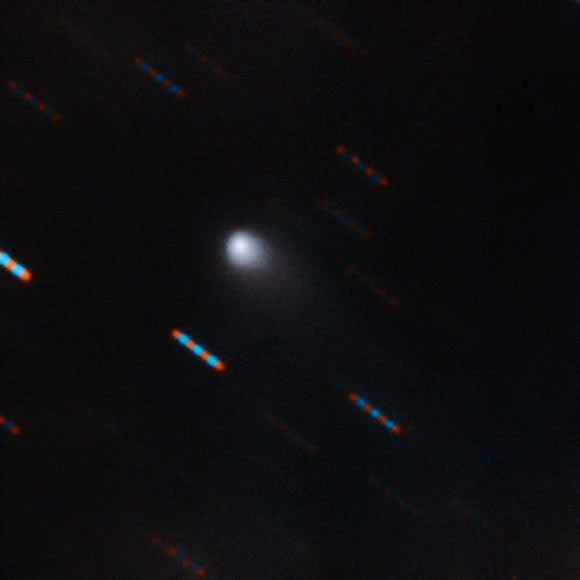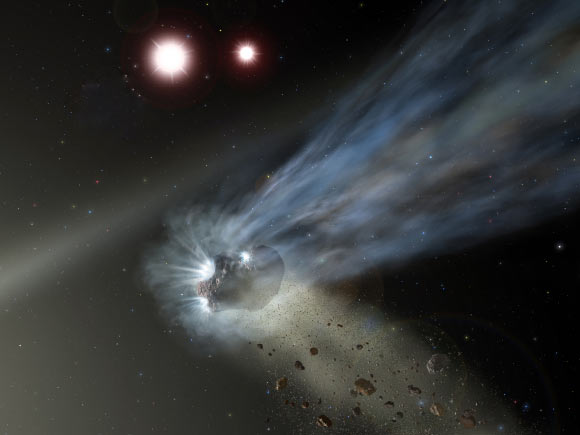Diatomic Carbon Detected in Interstellar Comet 2I/Borisov | Astronomy – Sci-News.com
Astronomers have detected the emission from the small carbon chains C2 in the coma of 2I/Borisov, the first known interstellar comet to visit our Solar System.

This composite image, obtained by the Gemini North Multi-Object Spectrograph on the 8.2-m Gemini North telescope, shows the interstellar comet C/2019 Q4. Image credit: Gemini Observatory / NSF / AURA / Travis Rector.
2I/Borisov is a relatively large active comet, between 1.2 and 10 miles (2-16 km) in diameter, with a condensed coma and a broad, short tail.
Also known as C/2019 Q4, the comet was discovered by Ukrainian amateur astronomer Gennady Borisov on August 30, 2019.
Astronomers around the globe immediately jumped into action, mobilizing the most powerful ground-based telescopes to measure the interstellar visitor’s orbit, color and other characteristics.
Dr. Piotr Guzik of the Jagiellonian University’s Astronomical Observatory and colleagues obtained images with the William Herschel Telescope and the Gemini North telescope, finding 2I/Borisov’s color to be indistinguishable from solar system comets.
A research team led by Dr. Julia de Leon of the Instituto de Astrofisica de Canarias obtained a spectrum of 2I/Borisov and found it to resemble those of typical cometary nuclei.
The team also plotted the comet’s current trajectory and calculated that it entered the Solar System from interstellar space at 76,000 mph (33.8 km/s) in the constellation of Cassiopeia.
Furthermore, Dr. Piotr Dybczynski from the A. Mickiewicz University and co-authors found that 2I/Borisov likely came from Kruger 60, a binary stellar system located 13.15 light-years away in the constellation of Cepheus.
Another team, headed by Queen’s University Belfast Professor Alan Fitzsimmons, detected cyanide (CN) gas — a common ingredient of solar system comets — in the coma of 2I/Borisov.

An artist’s depiction of a comet and red dwarfs Kruger 60A and B. Image credit: NASA / SOFIA / Lynette Cook / Sci-News.com.
In a new study, Teddy Kareta from the University of Arizona’s Lunar and Planetary Laboratory and colleagues used the 2.3-m Bok telescope at Kitt Peak National Observatory and the 6.5-m MMT telescope to search for and measure the abundance of molecules in the comet’s coma.
“The discovery of the second-ever interstellar object 2I/Borisov presents a unique opportunity to contrast planetesimal formation in our Solar System with formation processes in other solar systems — in a way not possible with the first interstellar object found, 1I/’Oumuamua,” they noted.
Kareta and co-authors observed 2I/Borisov on September 20 with the Boller & Chivens spectrograph at the Bok telescope and on October 1 with the Blue Channel spectrograph at the MMT telescope.
The comet was 2.67 AU away from the Sun and 3.25 AU from the Earth at the time of observations on September 20th, and 2.5 AU from the Sun and 3 AU from the Earth on October 1st.
The astronomers detected the emission from diatomic carbon (C2) in its coma and confirmed the earlier detection of cyanide gas.
They also found that 2I/Borisov is depleted in C2 relative to CN.
“In our Solar System, Jupiter-family comets are the most likely to be depleted,” they said.
“Within this context, we might expect 2I/Borisov to have formed in a location more similar to many of these comets, derived from the trans-Neptunian region, than the long period comets, which likely formed near Uranus and Neptune.”
“More work is needed to understand if 2I/Borisov being carbon-depleted has the same implications as it does in solar system comets.”
“A reliable detection of the molecule C3 in the spectrum of 2I/Borisov would help address this.”
The findings will be published in the Astrophysical Journal Letters.
_____
Theodore Kareta et al. 2019. Carbon Chain Depletion of 2I/Borisov. ApJL, in press; arXiv: 1910.03222





